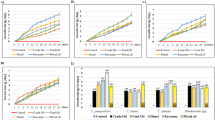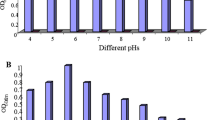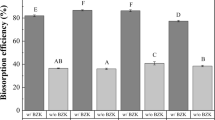Abstract
In practical bioremediation of petroleum pollution, treatment systems often use soil, sand, and other aquifer porous media besides water solutions. The distribution of the microbial cell also plays an important role in the whole process of bioremediation; therefore, the adhesion ability of cells to porous media is one of the key factors influencing the efficiency of treatment. The probable modes of hydrocarbon uptake in cells of Candida were studied based on data for cell hydrophobicity, emulsifying activity, surface tension, and interfacial tension of the cell-free culture medium. Six Candida strains were cultivated in insoluble and soluble substrates for 144 h, including n-hexadecane, soybean oil, ground-nut oil refinery residue, corn steep liquor, and glucose. The results obtained showed the potential of yeasts for application in the removal of hydrophobic compounds. Depending the strain and substrate used the adhesion ability of yeast cells and the production of surfactants and emulsifiers can take place simultaneously, thus increasing the efficiency of bioremediation treatment of petroleum pollution. The application of crude biosurfactants separated from the yeast cells was also demonstrated by tests of removal of petroleum and the derivate motor oil adsorbed in sand samples. Biosurfactants produced in low-cost medium were able to remove 90% of the hydrophobic contaminants.

Similar content being viewed by others
References
Van-Hamme JD, Singh A, Ward OP (2006) Physiological aspects Part 1 in a series of papers devoted to surfactants in microbiology and biotechnology. Biotechnol Adv 24:604–620
Canet R, Birnstingl JG, Malcolm DG, Lopez-Real JM, Beck AJ (2001) Biodegradation of polycyclic aromatic hydrocarbons (PAHs) by native microflora and combinations of white-rot fungi in a coal-tar contaminated soil. Biores Technol 76:113–117
Sotirova A, Spasova D, Vasileva-Tonkova E, Galabova D (2007) Effects of rhamnolipid-biosurfactant on cell surface of Pseudomonas aeruginosa. Microbiol Res (doi:10.1016/j.micres.2007.01.005; available at http://www.sciencedirect.com)
Rufino RD, Sarubbo LA, Campos-Takaki GM (2007) Enhancement of stability of biosurfactant produced by Candida lipolytica using industrial residue as substrate. W J Microbiol Biotechnol 23:729–734
Sarubbo LA, Marçal MCR, Neves MLC, Silva MPC, Porto ALF, Campos-Takaki GM (2001) Bioemulsifier production in batch culture using glucose as carbon source by Candida lipolytica. Appl Biochem Biotechnol 95:59–67
Sarubbo LA, Farias CBB, Campos-Takaki GM (2007) Co-utilization of canola oil and glucose on the production of a surfactant by Candida lipolytica. Curr Microbiol 54:68–73
Singh A, Van-Hamme JD, Ward OP (2007) Surfactants in microbiology and biotechnology: Part 2. Application aspects. Biotechnol Adv 25:99–121
Cortis A, Ghezzehei TA (2007) On the transport of emulsions in porous media. J Colloid Interface Sci 313:1–4
Vasileva-Tonkova E, Galabova D, Stoimenova E, Lalchev Z (2008) Characterization of bacterial isolates from industrial wastewater according to probable modes of hexadecane uptake. Microbiol Res 163:481–486
Hommel RK (1994) Formation and function of biosurfactants for degradation of water-soluble substrates. In: Ratledge C (ed) Biochemistry of microbial biodegradation. Kluwer Academic, Dordrecht, pp 63–87
Vasileva-Tonkova E, Gesheva V (2005) Glycolipids produced by Antartic Nocardioides sp. during growth on n-paraffin. Process Biochem 40:2387–2391
Cooper DG, Goldenberg BG (1987) Surface active agents from two Bacillus species. Appl Environm Microbiol 53:224–229
Rosenberg M, Gutnik D, Rosenberg E (1980) Adherence of bacteria to hydrocarbons: a simple method for measuring cell-surface hydrophobicity. FEMS Microbiol Lett 9:29–33
Associação Brasileira de Normas Técnicas (ABNT) (1982) NBR8492: tijolo maciço de solo-cimento: determinação da resistência à compressão e da absorção de água, método de ensaio. ABNT, Rio de Janeiro
Luna JM, Sarubbo LA, Campos-Takaki GM (2008) A new biosurfactant produced by Candida glabrata UCP1002: characteristics of stability and application in oil recovery. Brazilian Arch Biol Technol (in press)
Hua Z, Chen J, Lun S, Wang X (2003) Influence of biosurfactants produced by Candida antarctica on surface properties of micro-organism and biodegradation of n-alkanes. Water Res 37:4143–4150
Bouchez-Naïtali M, Rakatozafy H, Marchal R, Leveau J, Vandecasteele JP (1999) Diversity of bacterial strains degrading hexadecane in relation to the mode of substrate uptake. J Appl Microbiol 86:421–428
Banat IM, Makkar RS, Cameotra SS (2000) Potential applications of microbial surfactants. Appl Microbiol Biotechnol 53:495–508
Adamczak M, Bednarski W (2000) Influence of medium composition and aeration on the synthesis of surfactants produced by Candida antarctica. Biotechnol Lett 22:313–316
Sobrinho HBS, Rufino RD, Luna JM, Salgueiro AA, Campos-Takaki GM, Leite LFC, Sarubbo LA (2008) Utilization of two agroindustrial by-products for the production of a surfactant by Candida sphaerica UCP0995. Process Biochem 43:912–917. doi:10.1016/j.procbio.2008.04.013
Abu-Ruwaida AS, Banat IM, Haditirto S, Salem A, Kadri M (1991) Isolation of biosurfactant-producing bacteria—product characterization and evaluation. Acta Biotecnol 2:315–324
Kuyukina MS, Ivshina IB, Makarov SO, Litvinenko LV, Cunningham CJ, Philip JC (2005) Effect of biosurfactants on crude oil desorption and mobilization in a soil system. Environ Int 31:155–161
Joshi S, Bharuch C, Jha S, Yadav S, Nerurkar A, Desai AJ (2008) Biosurfactant production using molasses and whey under thermophilic conditions. Biores Tecnol 99:195–199
Acknowledgments
This work was financially supported by Conselho Nacional de Desenvolvimento Científico e Tecnológico (CNPq) and Universidade Católica de Pernambuco, Brazil. We are grateful to Núcleo de Pesquisas em Ciências Ambientais (NPCIAMB) laboratories, Universidade Católica de Pernambuco, Brazil.
Author information
Authors and Affiliations
Corresponding author
Rights and permissions
About this article
Cite this article
Coimbra, C.D., Rufino, R.D., Luna, J.M. et al. Studies of the Cell Surface Properties of Candida Species and Relation to the Production of Biosurfactants for Environmental Applications. Curr Microbiol 58, 245–251 (2009). https://doi.org/10.1007/s00284-008-9315-5
Received:
Revised:
Accepted:
Published:
Issue Date:
DOI: https://doi.org/10.1007/s00284-008-9315-5




